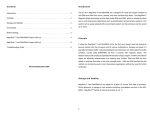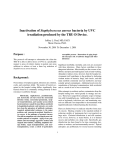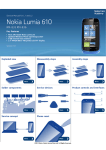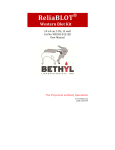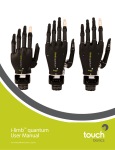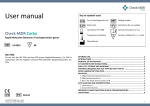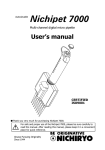Download Contents Introduction Principle Storage and Stability
Transcript
Contents Introduction Introduction.. . . . . . . . . . . . . . . . . . . . . . . . . . . . . . . . . . . . . . . . . . . . . . . . . . . . . . . . 2 The Mag-Bind™ Blood RNA Kit is designed for rapid and reliable isolation of total and viral RNA from mammalian whole blood. The Mag-Bind™ Magnetic Beads technology provide Principle. . . . . . . . . . . . . . . . . . . . . . . . . . . . . . . . . . . . . . . . . . . . . . . . . . . . . . . . . . . 2 high quality RNA, which is suitable for direct use in most downstream applications such as amplifications and enzymatic reactions. This system can be easily adapted with an Storage and Stability. . . . . . . . . . . . . . . . . . . . . . . . . . . . . . . . . . . . . . . . . . . . . . . . . 2 automated system and the procedure can be scaled up or down. Kit Contents. . . . . . . . . . . . . . . . . . . . . . . . . . . . . . . . . . . . . . . . . . . . . . . . . . . . . . . . 3 Before Starting. . . . . . . . . . . . . . . . . . . . . . . . . . . . . . . . . . . . . . . . . . . . . . . . . . . . . . 3 Principle Mag-Bind™ Blood RNA Protocol. . . . . . . . . . . . . . . . . . . . . . . . . . . . . . . . . . . . . . . . 4 Quantization and quality of RNA. . . . . . . . . . . . . . . . . . . . . . . . . . . . . . . . . . . . . . . . 7 If using the Mag-Bind™ Blood RNA Kit for the first time, please read this booklet to become familiar with the procedure and its various modifications. Samples are lysed in a specially Troubleshooting Guide. . . . . . . . . . . . . . . . . . . . . . . . . . . . . . . . . . . . . . . . . . . . . . . . 8 formulated buffer containing detergent and chaotropic salt. After adjust the buffer condition, nucleic acids (DNA/RNA) will form a complex with magnetic beads.. The beads/nucleic acids complex is separated from lysates using a magnet. Proteins and cellular debris are efficiently washed away by a washing step. Next, DNA is removed by DNase I treatment. RNA is re-bound and cleaned from the DNase I reaction mixture using a second magnetic beads binding and washing procedure. Finally, pure RNA is then eluted in nuclease-free water or low ionic strength buffer. Purified RNA can be directly used in downstream Revised September 2008 applications without the need for further purification. Storage and Stability Mag-Bind™ Blood RNA Kit are stable for at least 12 months from date of purchase. During shipment, or storage in cool ambient conditions, precipitates may form in the MRB Lysis Buffer. It is possible to dissolve such deposits by warming the solution at 37oC, though we have found that they do not interfere with overall performance. DNase I, DNase Digestion Buffer has to be stored at -20EC. Mag-Bind™ Particle R need to be stored at 4-8E C. 2 Kit Contents Please take a few minutes to read this booklet thoroughly and become familiar with Product the protocol. Prepare all materials required before starting in order to minimize M2837-00 M2837-01 M2837-02 1 x 96 4 x 96 12 x 96 1 4 12 Mag-Bind™ Particles RV 1 mL 4 mL 12 mL Buffer MRB 20 ml 80 mL 250 mL Proteinase K 40 mg 160 mg 3 x 160 mg # During the procedure work carefully but quickly. # Under cool ambient conditions, crystals may form in MRB Bufer This is normal and Purification Process Plate Buffer MBW 35 ml 140 ml 400 ml SPR Wash Buffer 25 mL 125 mL 3 x 125 mL DEPC-Water 10 mL 40 mL 80 mL DNase I** 160 µl 640 µl 1920 µl DNase Digestion Buffer** 5.5 mL 22 mL 66 mL 1 1 1 User Manual RNA degradation. Wear gloves/protective goggles and take great care when working with chemicals. # Whenever working with RNA, always wear latex gloves to minimize RNase contamination. Use only clean RNase-free disposable plastic pipette tips when using the supplied reagents. the bottle should be warmed to re-dissolve the salt. Material and Equipments supplied by User Have the following reagents and supplies ready before starting procedure: * Store Mag-Bind™ Particle R at 4-8EC. * DNase I and DNase digestion Buffer has to be shipped and stored at -20C. # Magnetic separation device for 96 well microplate (MSD-01) # Nuclease-free 96-well # Multichannel pipette # Nuclease-Free pipetting tips # Absolute ethanol (96-100%) # Isopropanol Before Starting SPR Wash Buffer must be diluted with absolute ethanol before use. M2837-00 Add 75 mL 100% ethanol M2837-01 Add 375 mL 100% ethanol M2837-02 Add 375 mL 100% ethanol Mag-Bind ™ Blood RNA Isolation Protocol (for 50ul Blood) Buffer MBW must be diluted with isopropanol before use. The following protocol is designed for isolating total RNA from Fresh Whole Blood. For best RNA quality, always use blood that has not been frozen. Frozen blood can be used with this protocol, however, RNA quality could be compromised as the results of freezethawing process. M2837-00 Add 35 ml Isopropanol 1. M2837-01 Add 140 ml Isopropanol Prepare a Lysis Mixture by mixing one volume of Buffer MRB and one volume of isopropanol. For 96 samples, combine15 ml Buffer MRB with 15 ml isopropanol and mix throughly by vortexing. Add 300 ìl Lysis Mixture for each sample at step 3. M2837-02 Add 400 ml Isopropanol 2. Add 50 ul blood sample into Processing Plate (supplied) followed by adding 10 ul Proteinase K solution and 10 ul Mag-Bind™ Particle R. IMPORTANT Dissolve Proteinase K as following and store at -20EC. M2387-00 Add 1ml DEPC-Water M2387-01 Add 4 ml DEPC-Water M2387-02 Add 4 ml DEPC-Water Note: Proteinase K and Mag-Bind™ Particles R can be prepared as master mix and add to each at one time. For 96 samples, mix 1 vial Mag-Bind™ Particle R (1 ml) with 1 ml Proteinase K solution. Add 20 ìl beads/proteinase K mix for each blood sample. 3 4 3. Add 300ul Lysis Mixture, shaking for 10 minutes at room temperature. Note: If total nucleic acid (DNA and RNA) is desired, skip this DNase I digestion steps (step 14-21) and proceed step 17 for isolating both DNA and RNA. 4. Place the Processing Plate on a magnetic separation device to magnetize the magnetic particles. Leave the plate on the magnet until all the magnetic particles are pelleted. The capture time is depend on the sample type and magnetic stand used. If Omega Bio-tek MSD-01 is used, it normally take 7-15 minutes. 5. Carefully aspirate and discard the supernatant without disturbing the magnetic particles. 6. Remove the Processing Plate containing the magnetic particles from the magnetic separation device. Add 300 ìl of Buffer MBW and resuspend magnetic particles pellet by pipetting up and down or vortex the plate at maximum speed for 1 minute. 7. Place the plate onto a magnetic separation device to magnetize the magnetic particles. Aspirate and disacrd the cleared supernatant after the lysate is cleared. 8. Remove the plate containing the magnetic particles from the magnetic separation device. Add 400 ìl of SPR Wash Buffer to each well and resuspend magnetic particles pellet by pipetting up and down or vortexing for 30 seconds. 9. Place the plate onto a magnetic separation device to magnetize the magnetic particles. Aspirate an discard the cleared supernatant after the lysate is cleared. 10. Leave the tube on the magnetic separation device. Prepare the DNase I digestion mix as following table. Note: If total nucleic acid (DNA and RNA) is desired, skip this DNase I digestion steps (step 14-21) and proceed step 17 for isolating both DNA and RNA. Number of Samples DNase I Digestion Buffer DNase I Total Volume 1 48.5 µl 1.5 µl 50 µl 4 213.5 µl* 6.6 µl* 220 µl 10 534 µl* 16.5 µl* 550.5 µl 96 5.12 ml 158.5 ìl 5278 ìl 11. Add 50 µl of DNase I digestion mix and resuspend the magnetic particles by pipetting up and down for 20 times or vortexing. Incubate at room temperature for 10-15 minutes. Note: It is very important to remove any liquid drop from the wells of the process plate before adding the DNase I digestion mix. DNase I digestion Mix must be used immediately once it is prepared. 12. Add 300 µl Buffer MBW and mix throughly by vortexing for 3 minutes. Incubate at room temperature for 5-10 minutes. 13. Place the plate onto a magnetic separation device to magnetize the magnetic particles. Aspirate the cleared supernatant after the lysate is cleared. 14. Add 400 ìl of SPR Wash Buffer and resuspend magnetic particles pellet by pipetting up and down for 20 times or vortexing at maximum speed for 30 seconds. 15. Place the plate onto a magnetic separation device to magnetize the Mag-Bind™ particles. 16. Aspirate and discard the cleared supernatant. Carefully remove any liquid drop from tube. Leave the tube on the magnet stand. Air dry the magnetic particles at room temperature for 7-10 minutes. 17. Add 20-50 µl DEPC Treated water and resuspend magnetic particles pellet by vortexing or pipetting up and down for 20 times. Incubate at room temperature for 3 minutes. 18. Place the tube onto a magnetic separation device to magnetize the Mag-Bind™ particles. 19. Transfer the cleared supernatant contains purified RNA into a new RNase-free microplate . Quantification of RNA * Volume are calculated 10% extra to offset the pipetting error. 5 6 To determine the concentration and purity of RNA, one should measure the absorbance Trouble Shooting at 260 nm and 280 nm in a spectrophotometer. 1 O.D. unit measured at 260 nm corresponds to 40µg of RNA per ml. DEPC treated water is slightly acidic and can Problem Likely Cause Suggestions dramatically lower absorbance values. We suggest that you dilute the sample in a Low RNA yields Incomplete resuspension of magnetic particles Resuspend the magnetic particles by vortexing before use. RNA degraded during sample storage Make sure the sample is properly stored and make sure the samples are processed immediately after collection or removal from storage. SPR Buffer were not prepared correctly. Prepare the SPR Buffer by adding ethanol according to instruction Loss of magnetic beads during operation Becareful not to remove the magnetic beads during the operation Undissolved particles in the cell lysate cause congregation of magnetic beads make sure the lysate is clear of particles before adding magnetic beads. No RNA eluted. MBW and SPR Wash Buffer Concentrate not diluted with absolute ethano or isopropanol. Prepare VRB and SPR Wash Buffer Concentrate as instructed on the label. Problem with downstream application Insufficient RNA was used 1. RNA in the sample is already degraded; do not freeze and thaw the sample more than once or store at room temperature for too long buffered solution (TE) for spectrophotometric analysis. The A260/A280 ratio of pure nucleic acids is 2.0, while for pure protein is approximately 0.6. Therefore, a ratio of 1.8-2.0 corresponds to 90-100% pure nucleic acid. Phenol has a maximum absorbance at 275 nm and can interfere with absorbance readings of DNA or RNA. However, the E.Z.N.A.™ Total RNA Kit eliminates the use of phenol and avoids this. RNA Quality It is highly recommended that RNA Quality be determined prior to all analysis. The quality of RNA can be best assessed by denaturing agarose gel electrophoresis and ethidium bromide staining. Two sharp bands should appear on the gel. These are the 28S and the 18S (23S and 16S for bacteria) ribosomal RNA bands. If these band appears as a smear towards lower molecular weight sized RNAs, the it is likely that your RNA has undergone major degradation during preparation, handling, or storage. Although RNA molecules less than 200 bases in length do not efficiently bind to the HiBind® matrix, a third RNA band, the tRNA band, may be visible when a large number of cells are used 2. Quantify the purified RNA accurately and use sufficient DNA. Carryover of the magnetic beads in the elution Carryover from the magnetic beads in the eluted RNA will not effect downstream applications. To remove the carryover magnetic beads from eluted RNA, simply magnetize the magnetic beads and carefully transfer to a new tube or plate. DNA contamination Inefficient of DNase I digestion 1. Make sure to use proper starting material 2. Ensure that the temperature of DNase I digestion at 20-25E C. 7 8




